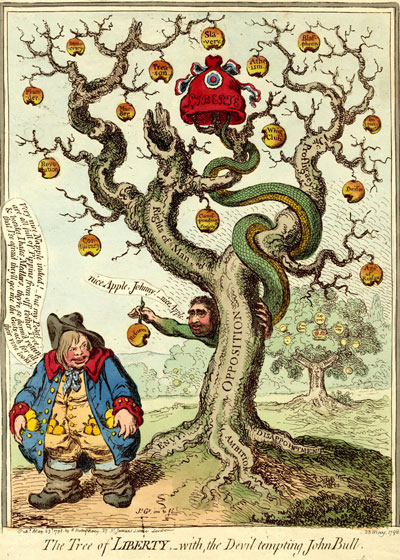The Tree of Liberty, with the Devil Tempting John Bull
Along with the bonnet rouge, the carmagnole, and sans culottes, the tree of liberty was one of the most popular and enduring symbols of French revolutionary activity. Meant to suggest the natural and organic spread of liberty from one region to another, a tree of liberty would be planted by revolutionaries whenever they conquered and occupied a new area. Sometimes it was a literal tree as shown here, but just as often it was a pole decorated with other revolutionary symbols such as we see in the frontispiece to Hollandia Regenerata.

© Trustees of the British Museum
In Christian mythology, the best known tree is probably the tree of the knowledge of good and evil from the book of Genesis, the tree whose forbidden fruit was the basis of the devil's temptation of Eve. As the son of a Moravian sexton and the product of a Moravian school where the essential depravity of man, resulting from the orginal sin of Eve's, was insisted upon, it is not suprising that Gillray would have seen the French tree of liberty as an analogue of that fatal tree. And given the number of times Gillray had portrayed the leader of the opposition Whigs in Parliament, Charles James Fox, as Satan,* it is also no surprise that Fox should be portrayed as the devil himself offering the false fruit of French ideology to the typical Englishman, John Bull.
As Gillray portrays it, the suspiciously twisted tree of liberty promoted by Fox and the Whigs in the name of "Reform" is barren and leafless. It is NOT rooted in the best interests of ordinary Englishmen, but in Fox's and the Opposition's own "Disappointment," "Envy," and "Ambition." And among the rotten and half-eaten fruit of that tree are both political and religious transgressions, including "Conspiracy," "Treason," "Murder," and "Atheism," "Blasphemy," and "Impiety."
The French Tree of Liberty is contrasted with the verdant and homegrown English tree in the background. That draws its strength from the three foundational roots of British political life: the "Commons," the "King," and the "Lords." Those roots produce a solid and upright trunk of "Justice," with branches of "Law" and "Religion." The fruits of that tree include "Freedom," "Happiness," and "Security."
By May 1798, after two abortive attempts at an invasion by France, Fox and the Whigs had lost almost all the support they had at the beginning of the revolution. And even the repressive measures instituted by Pitt such as the suspension of habeas corpus were tolerated as necessary. So in this print, a very well stuffed John Bull is portrayed as not deceived or misled by the blandishments of Fox.
Very nice N'apple indeed! - but my Pokes are all full of Pippins from off t'other Tree: & besides, I hates Medlars, they're so domn'd rotten! that I'se afraid they'll gie me the Guts-ach for all their vine looks.
* Some of the prints showing Fox as Satan, the Devil, or a tempter include:
- Gloria Mundi, or the Devil Addressing the Sun (1782)
- Aside He Turn'd for Envy... (1782)
- The Republican Rattle-Snake Fascinating the Bedford-Squirrel (1795)
- The Nuptial Bower with the Evil-One, Peeping at the Charms of Eden (1797)
- Le Diable-Boiteux, or the Devil upon Two Sticks. . . (1806)
Sources and Reading
- Commentary from the British Museum on The Tree of Liberty, with the Devil Tempting John Bull.
- Christiane Banerji and Diana Donald, Gillray Observed, 1999, Ch. 3.
- Draper Hill, The Satirical Etchings of James Gillray, 1976,#56.
- "Symbolism in the French Revolution," Wikipedia
- "Charles James Fox," Wikipedia
- Thomas Wright and R.H. Evans, Historical and Descriptive Account of the Caricatures of James Gillray #200.
- Thomas Wright and Joseph Grego, The Works of James Gillray, the Caricaturist; With the History of His Life and Times, p. 240.
Comments & Corrections
NOTE: Comments and/or corrections are always appreciated. To make that easier, I have included a form below that you can use. I promise never to share any of the info provided without your express permission.